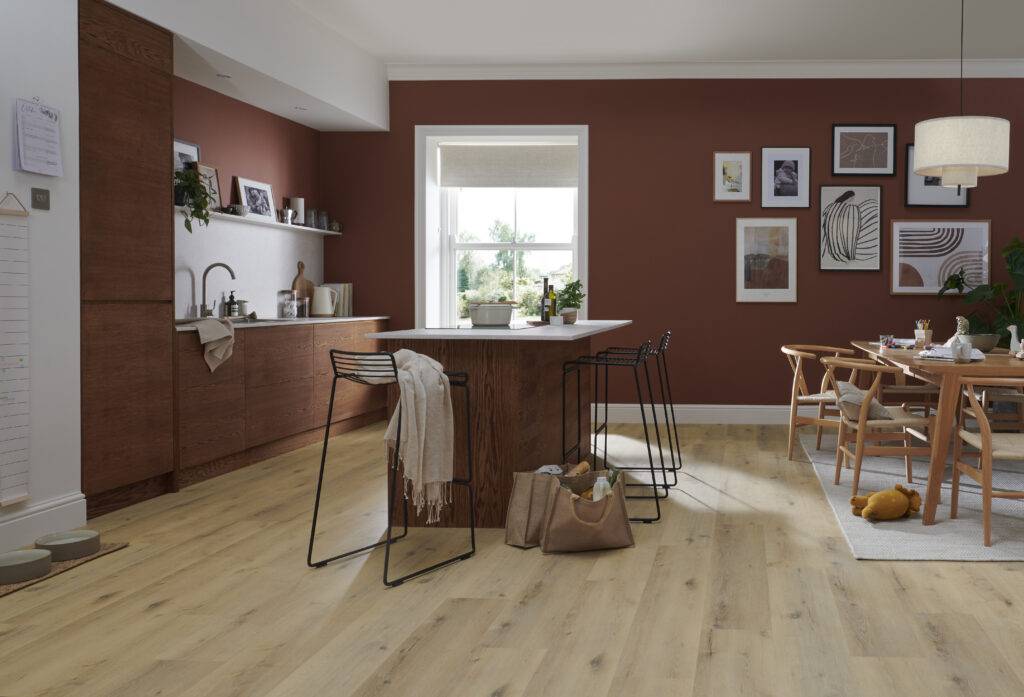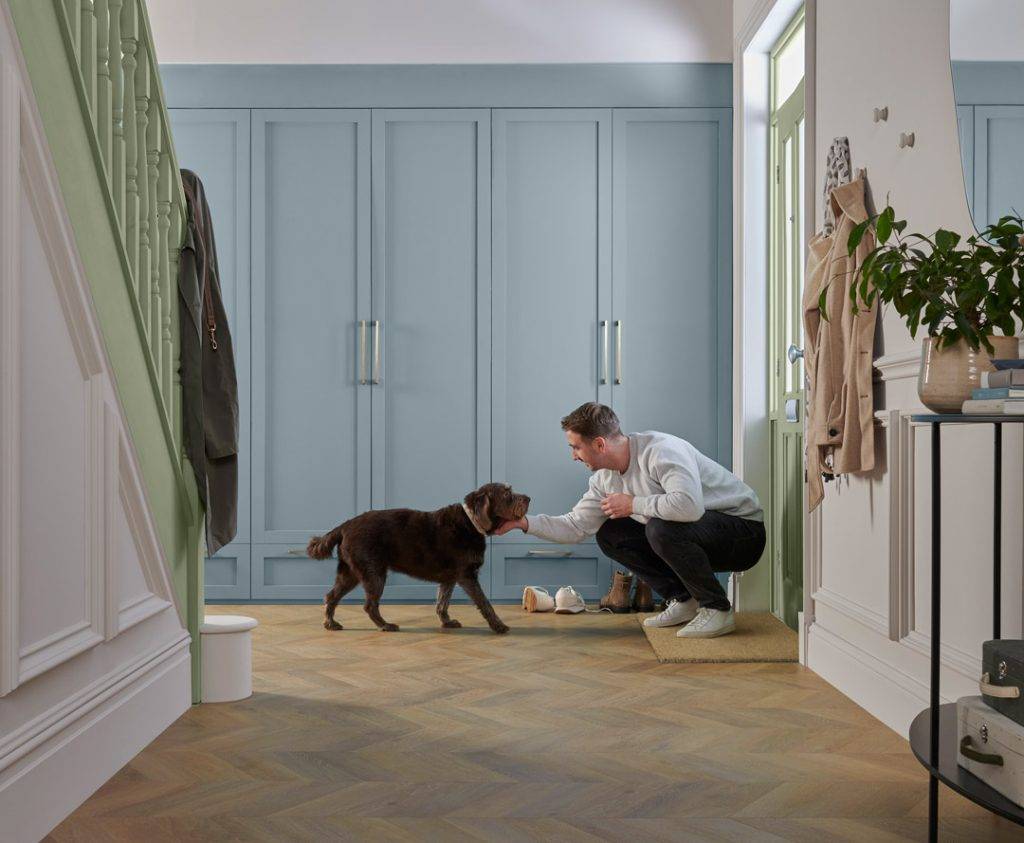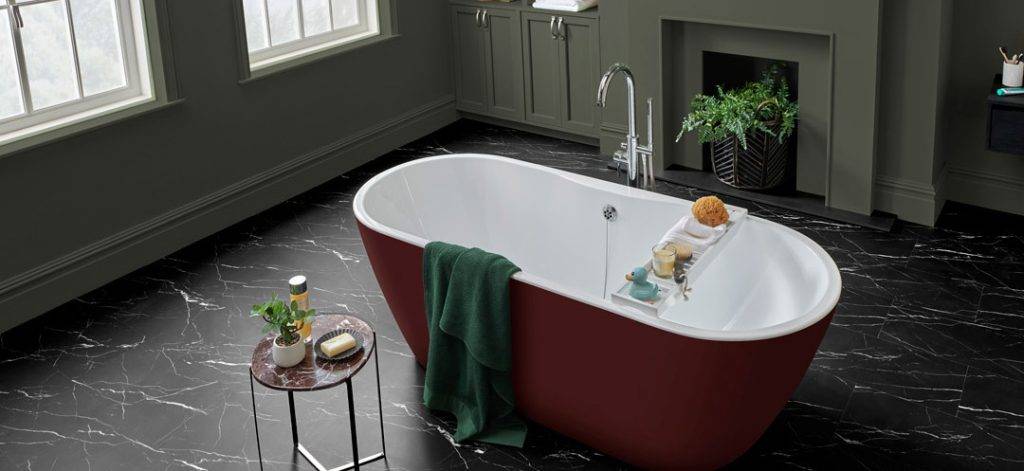Building homes from the floor up
Up to 3 FREE Samples
Building homes from the floor up
Up to 3 FREE Samples
What flooring is best for kitchens? The kitchen is supposed to be a very clean, sterile place – it’s where food is prepared and cooked and it is also likely to be one of the busiest rooms in the home so you need a type of flooring that is both hard-wearing and easy to keep clean. Enter Luxury Vinyl Tiles, better known as LVT.
Here at Luvanto, we believe LVT is a contender for all rooms in the home, but for the kitchen, it might just be perfect.
Ceramic and standard vinyl have both often been tied to the traditional flooring for a kitchen. To fully understand why, and which is the better of the two, we’ll first start by comparing standard vinyl to LVT.
Resistance – Kitchens with vinyl floors benefit from a perfect resistance to liquid. When liquid is spilt on a vinyl sheet floor, it gathers on the surface, making it easy to clean and maintain. All you need as a cleaner for vinyl flooring is a mop and bucket. The same can be said for LVT when it has been properly installed.
The one thing to bear in mind with LVT is that a poorly fitted installation completed by an inexperienced fitter may lead to less secure seams which could allow for liquid to seep through to the subfloor. For this reason, you should always use an experienced professional flooring installer so that your tiles will be able to do the job they were intended for.
Luvanto has a range of tiles, each with a different strength to offset the few problems that LVT has. For example…
Direct Sunlight Damage: Both standard vinyl and LVT can have issues with direct sunlight in terms of fading, and this may be a consideration for you. Luvanto does have the added advantage of a UV coating over the wear layer which means that this will be less of an issue and far less noticeable overtime.
Luvanto is a premium product designed to bring out the maximum protection your home deserves. The result of this is high-quality flooring with all the original benefits of LVT, alongside a very strong surface that resists UV, scratches and dents. Ideal for your kitchen you might say.
Comfort – Unfortunately, standard vinyl is a very thin material, so thin that you can usually feel the hard subfloor beneath it. This makes it not the most comfortable flooring option for the kitchen.
LVT, on the other hand, is the exact opposite. Aside from carpets (which don’t work well within kitchens for very obvious reasons), LVT is possibly the most comfortable floor on the market. It has multiple layers of synthetic textile that compound together to create a soft feeling underfoot. Your kitchen will not only be comfortable on your feet but also warm, as it provides excellent insulation.
Design – When you’re asking what flooring is best for kitchens, people don’t always factor design in, but there’s no reason you can’t be creative in the kitchen too. Kitchens with vinyl floors can somewhat mimic any other material, which is why it’s a popular and cheap flooring choice. However, due to it having few seams, the tiling effect is not always entirely convincing.
LVT has more layers, meaning it’s manufactured through more rollers. The multiple layers allow for a more convincing print, allowing the material to perfectly mimic anything from stone to wood. LVT gives you all the visual appeal you need with easy installation and comfort.
Lifespan – Standard Vinyl has a lifespan of around ten years. Luxury vinyl has a lifespan of more than twice that, being around 25 years when it has been properly maintained. Considering that a person will change homes at least twice in their lifetime, there’s a good chance the floor will outlast your stay.
As a side note, having good quality flooring in your home will raise its appeal and value on the housing market should you be considering selling at some point in future.
Overall, LVT for kitchens is a better option over standard vinyl unless you are on a really limited budget. It has the right balance of quality, durability and looks, and will easily outlast standard vinyl to provide you with years of service that make it the best flooring investment for your kitchen.
Ask anyone what the best flooring for kitchens is, and many will likely tell you to use ceramic. Whilst it does have useful applications in a kitchen, there are some things you should consider first:
Installation – The installation of ceramic is a long, labour-intensive process which can take an intermediate fitter around 12 hours to lay down ceramic in the average sized room. This could mean that your kitchen would need to be out of commission for around two days for the job to be complete and able to be walked on again.
LVT, on the other hand, has an intuitive enough design that means it is easy to install for a skilled floorer. While some people with relatively decent DIY skills could attempt it, we still recommend you employ a skilled fitter so as not to void your warranty and ensure your flooring is laid effectively. Regardless, LVT is much faster to install, so the labour costs for its installation are far lower than some other types of flooring, especially ceramic.
Comfort – You’re going to spend a lot of time pacing around in the kitchen, whether it’s while you are cooking or just waiting for the kettle to boil. Having a hard ceramic floor underneath your feet is not the most comfortable to be standing on, especially if you are someone who spends long hours cooking in the kitchen. On top of that, ceramic is very cold and takes a long time to heat up or cool. All in all, it’s not a material you want to stand on for long periods.
As we already pointed out in the last section, luxury vinyl flooring is a comfortable option underfoot and has great thermal insulation which ensures better warmth when fitted in a kitchen.
Hard – At first, this quality might sound like that’s required when looking for the best flooring for kitchens. But there’s a difference between being hard and being strong. The unfortunate reality of ceramic is this – whilst it has excellent resistance to liquids (which is very important in the kitchen), it has a poor performance against hard objects. If you drop a plate onto the floor, it will usually shatter against the floor. It may also break the surface of the ceramic tile itself, meaning you need to replace that tile.
LVT is soft enough that it may prevent some kitchenware from breaking. After all, the cushion layer in LVT gives it a little more of softer landing for any items you drop. When LVT is damaged, you can easily replace damaged tiles through the intuitive click-lock system and replace the damaged speedily.
Slippery – Possibly the biggest drawback of ceramic flooring for self-evident reasons. Ceramic, even when it’s not wet, can be slippery underfoot. This problem is magnified when you add children or vulnerable people to the equation, and falling onto a hard surface can sometimes have unwanted consequences.
Luvanto’s range of high-tier LVT products boasts anti-slip on all of their flooring. Even whilst wet, the friction will afford you full balance and grip, meaning it is a far safer flooring option for the kitchen.
When it comes to ceramic flooring in kitchens, it might look visually appealing but it does not come without its issues. From the time taken to lay ceramic flooring, to the price, to comfort and safety — it all adds up to making ceramic perhaps not the best option for the kitchen.
LVT on the other hand offers many advantages beyond just cost and ease of installation. All in all, the durable, water-resistant, anti-slip, and comfortable properties make LVT more than a suitable option for your kitchen flooring.
Recently Viewed
Related Articles
The Natural LVT flooring trend: Bring the Outdoors in
Crafting Industrial Style: Decorating with Stone Effect LVT Flooring from Luvanto
How to Style Dark Flooring
How to Style Herringbone Flooring
Understanding LVT Specifications and Technical Details: Your Guide to a Perfect Floor
Waterproof LVT for High-Moisture Bathrooms
Clay Earth
Midnight Olive
Coastal Cottage




Trends come and go but a Luvanto floor is forever.
Keep your interiors looking show-home worthy with our colour and trend inspiration. As experts in colour forecasting and pairings, we match the latest trends and colours with each of our flooring shades so you can stay tickled pink with your décor all year round.
Flooring
Inspiration
Where To Buy
Help And Support
Copyright © 2024 Luvanto - QA Flooring Solutions Ltd. All Rights Reserved.
QA Flooring Solutions Ltd is a company registered in England
Registered Office: Unit 2 Hurricane Drive, Speke, Liverpool, L24 8RL
Company Registration Number: 07870268 | VAT Number: 852026449
| Cookie | Duration | Description |
|---|---|---|
| cookielawinfo-checkbox-analytics | 11 months | This cookie is set by GDPR Cookie Consent plugin. The cookie is used to store the user consent for the cookies in the category "Analytics". |
| cookielawinfo-checkbox-functional | 11 months | The cookie is set by GDPR cookie consent to record the user consent for the cookies in the category "Functional". |
| cookielawinfo-checkbox-necessary | 11 months | This cookie is set by GDPR Cookie Consent plugin. The cookies is used to store the user consent for the cookies in the category "Necessary". |
| cookielawinfo-checkbox-others | 11 months | This cookie is set by GDPR Cookie Consent plugin. The cookie is used to store the user consent for the cookies in the category "Other. |
| cookielawinfo-checkbox-performance | 11 months | This cookie is set by GDPR Cookie Consent plugin. The cookie is used to store the user consent for the cookies in the category "Performance". |
| viewed_cookie_policy | 11 months | The cookie is set by the GDPR Cookie Consent plugin and is used to store whether or not user has consented to the use of cookies. It does not store any personal data. |
Building homes from the floor up
Up to 3 FREE Samples